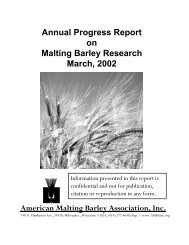Annual Progress Report on Malting Barley Research March, 2007
Annual Progress Report on Malting Barley Research March, 2007
Annual Progress Report on Malting Barley Research March, 2007
You also want an ePaper? Increase the reach of your titles
YUMPU automatically turns print PDFs into web optimized ePapers that Google loves.
Other <strong>Barley</strong> <strong>Research</strong>:<br />
Feed Program: The total number of crosses made for the barley breeding program in<br />
2006 was approximately 500. Of these, 350 were malt types. Thus the remaining<br />
crosses were feed and specialty types for high beta-glucan and low phytic acid. The<br />
n<strong>on</strong>-malt part of the breeding program is tested in early generati<strong>on</strong>s in c<strong>on</strong>juncti<strong>on</strong> with<br />
the malt types, and <strong>on</strong>ly after line derivati<strong>on</strong> are they separated. Feed types are tested<br />
at three fewer locati<strong>on</strong>s than are malt types and feed populati<strong>on</strong>s are typically not<br />
advanced via winter nurseries.<br />
Mapping studies:<br />
We are advancing several mapping populati<strong>on</strong>s: <strong>on</strong>e for high beta-glucan and four for<br />
high diastatic power. The high beta-glucan populati<strong>on</strong> (F7:9) will be evaluated for QTL in<br />
2008 at three locati<strong>on</strong>s. This is a collaborative effort with Dr Eric Jacks<strong>on</strong> at Aberdeen.<br />
The high diastatic power populati<strong>on</strong>s are currently at the F3 stage and are being<br />
advanced via single seed descent in the greenhouse. The high DP work is a<br />
collaborative effort with Eric Jacks<strong>on</strong>, Al Budde, Mark Schmidt, and Cynthia Hens<strong>on</strong>.<br />
Stripe Rust effort:<br />
We are collaborating with Dr Pat Hayes (and others) to introgress QTL for stripe rust<br />
resistance from the i-Bis<strong>on</strong> lines into our breeding program using marker assisted<br />
selecti<strong>on</strong>. This research is in the beginning phase as we have recently developed F1<br />
populati<strong>on</strong>s between the stripe rust d<strong>on</strong>or and our elite breeding lines. In additi<strong>on</strong> to the<br />
mapping effort per se, we plan to incorporate these sources of resistance into our best<br />
winter (Charles) and spring (Sublette) malting lines.<br />
CAP grant:<br />
We evaluated our 96 CAP breeding lines (spring types) for phenotypic characteristics<br />
and malt quality parameters at three locati<strong>on</strong>s in 2006 (Aberdeen, Filer, and Fenn for<br />
six-rowed types, and Aberdeen, Filer, and Soda Springs for two-rowed types). In<br />
additi<strong>on</strong>, our program also has 96 winter lines being evaluated as Pat Hayes has<br />
chosen to allot his porti<strong>on</strong> of the breeding lines to examine our winter breeding lines.<br />
Future Program Directi<strong>on</strong>:<br />
We envisi<strong>on</strong> that our program will c<strong>on</strong>tinue to expand as far as the number of<br />
populati<strong>on</strong>s and derived lines evaluated with a very large expansi<strong>on</strong> first beginning in<br />
2008 as we go from 12,000 to over 20,000 lines being evaluated per year. We<br />
anticipate that malting barley producti<strong>on</strong> will c<strong>on</strong>tinue to grow in Idaho and M<strong>on</strong>tana and<br />
we plan to release cultivars to meet the market demand. A major source of new barley<br />
could be winter types and we will have a full program in 2008-09. Our future allotment<br />
of resources will c<strong>on</strong>tinue to provide more resources for our winter program as it<br />
c<strong>on</strong>tinues to grow. Our breeding program will c<strong>on</strong>tinue to focus primarily <strong>on</strong> malt types<br />
versus feed types because malting barley is critical to Idaho and M<strong>on</strong>tana growers.<br />
15
















